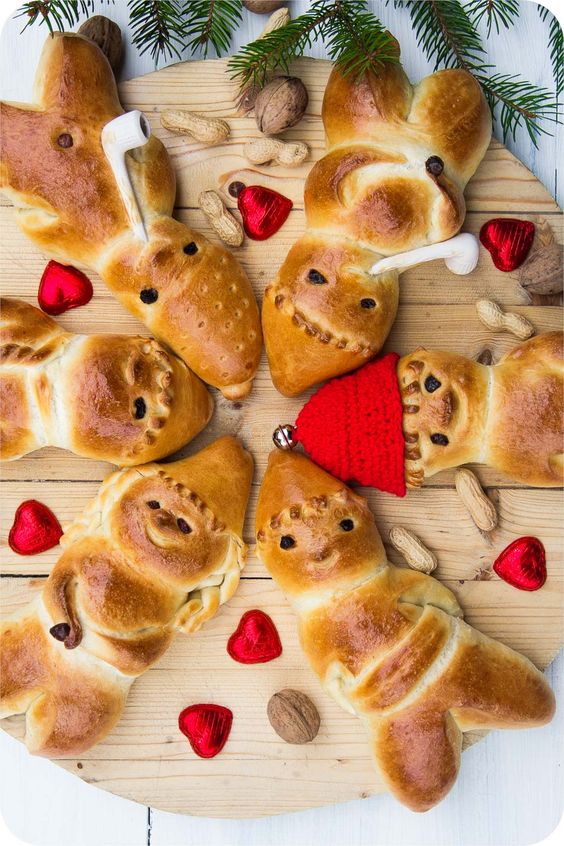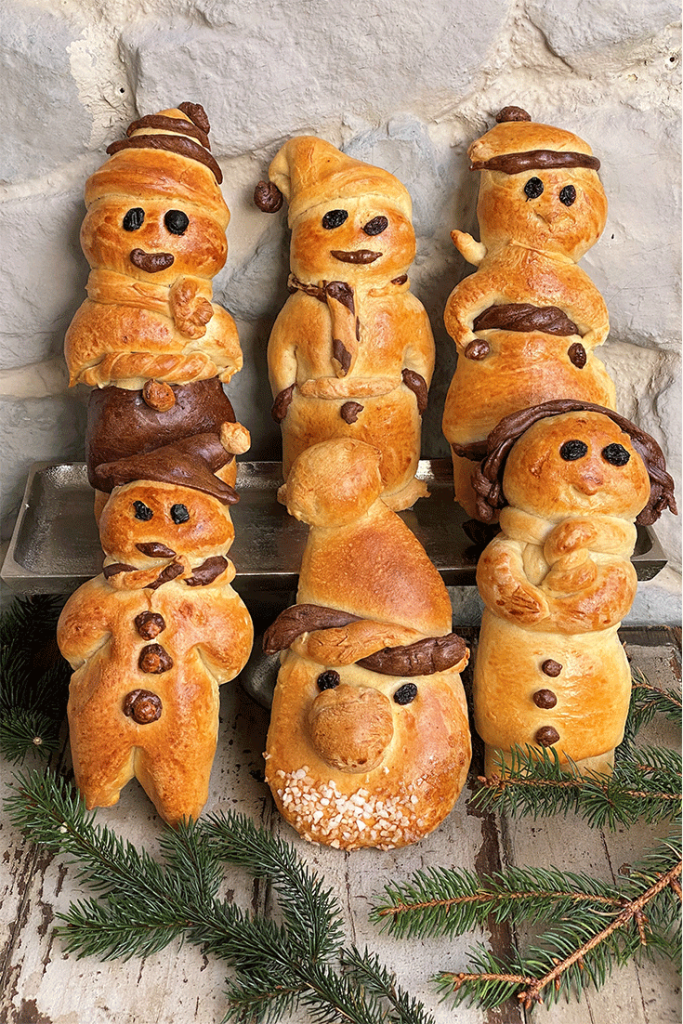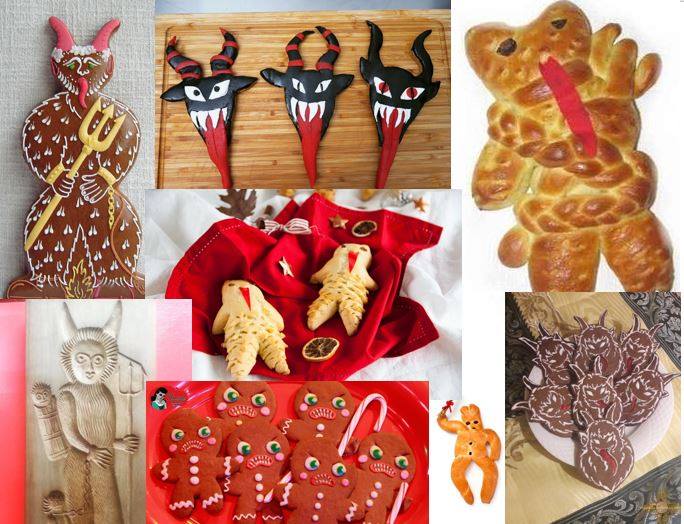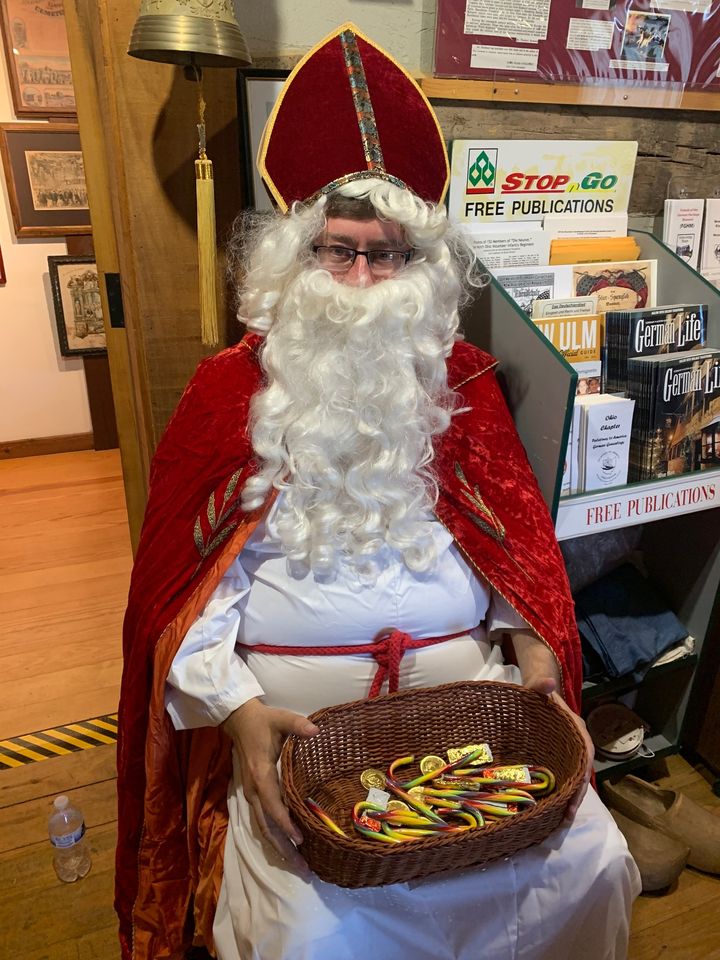
Above Photo: Grittibanz from Germanic Catholic northwest Switzerland.
There are two bishops in Germanic speaking Europe who have spawned the baking of ‘little man breads’ since the time of the Reformation. There’s a great story in Amsterdam in 1663 when the mayor of Amsterdam prohibited these breads and the arrival of St Nickolas on December 6 because he said they represented Catholic and or pagan images. That story inspired the Rankin Bass holiday Christmas special “Santa Claus is Coming to Town.” The character Burgermeister/Meisterburger represents the meany Mayor of Amsterdam.
While the priestly images of these two bishops – St. Martin and St. Nicholas – still exist in some of the regional breads in Catholic areas of Germanic speaking Europe, they have spawned secular, breads that look more like gingerbread men in the Protestant and non-Catholic regions. There is even a whole other offshoot of these breads made to look like Krampus, the hairy evil beast who accompanies St. Nicholas in Bavaria and Austria to deal with naughty children (and adults). They’re said to be made with Krampus’ sweat for added flavor.
St. Martin’s Day is November 11 in Germanic Europe and signifies the start of the crazy Carnevale/Fasnet/Fastnacht season, particularly in Cologne. On this day breads made to represent St. Martin, called Weckmann, holding little clay pipes and with eyes and buttons made of raisins, are distributed to children by a St. Martin, dressed as a bishop riding a horse. Children also march in elaborate night lantern parades. Last year I made Weckmann on St. Martin’s Day for my niece and nephews, and then on Krampusnacht on December 5, Drew Rath of Tuba Baking specially made an awesome, chocolate-coated, fruit-filled Krampusbrot for our celebration. He has not revealed where he obtained the Krampus sweat used.

Above photo – My version of Weckmann for St. Martin’s Day last year.

Above Photo: Krampusbrot made by Drew Rath at Tuba Baking, Dayton, Kentucky, 2021.
These little man pastries have a wide variety of names, depending on where you are in Central Germanic Europe. There are so many, in fact, that a Little Man Bread Map should be made and a travel podcast should be made to taste all the variations. Widespread in Germany in the Rhineland and Saarland, the Palatinate, in Hesse and in Baden-Württemberg, Franconia and in other parts of northern and partly also in eastern Germany is Weckmann, Weckmännchen, Weckenmann or Weckenmännchen.

Above photo: Stutenkerl
Stutenkerl or Mare are the names of these bread men in Lower Saxony, Schleswig-Holstein, Mecklenburg and Westphalia – the area where the term Mares is the common variant for a raisin bread.
In southern Germany and Austria, the pastry is known as Krampus, referring to the frightening figure accompanied by Saint Nicholas. In East Germany, the pastry is generally not widespread. In German-speaking Switzerland, the pastry is usually called Grittibänz.

In addition, there are regionally influenced names that are unknown outside of the particular micro-region: From the North Eifel to Cologne it is called Pitschmann, in the Bergisches Land they’re called Piefekopp, in the western Ruhr area and Rhineland , they’re called Pumann. In the dialects of Viersen they are called Mönchengladbach, and the surrounding area, they’re called Buckmann or Buggemann. In East Westphalia around the region of Lippe and in the eastern Münsterland it is also known as Piepenkerl.
In the area between the Danube and Lech (Bavarian Swabia and north of Lake Constance) the dough man is called Klausenmann, and in the area around Breisach he is the Baselmann. In Basel (and southwest Baden) it is the Grättimaa, in western Thurgau and eastern canton Zurich near the town of Elgg in Winterthur, he is called Elggermaa. In Luxembourg he is called Boxemännchen (plural: Boxemännercher), in Alsace Manele (Männele) or Manala, in Franche-Comté and in Alsace-Lorraine he is called Jean Bonhomme (Happy John).

above photo: Klausenmann

Above photo: Boxenmaennchen from Luxemburg.
In northern Rhineland-Palatinate it is called Ditz, in the North Baden-Palatinate-South Hesse area Dambedei, Maddinsmändl or Hefekerl, and in Eichsfeld one speaks of Martinsbrot. In Hesse, especially in the Rheingau, there is the Weggbopp
Finally, in the Netherlands, he is known as of Buikman, Wekkeman, Weckman, Weggekèl, Mikkeman, Stevensman, Piepespringer or Ziepesjprengert.
The names Stutenkerl and Weckmann refer to the type of dough and shape of the pastry: a little man made of flour, sugar, fat and yeast (mares) or from flour, salt, yeast and water (Wecken). Klausenmann takes its name from St. Nicholas. Buckmann refers to the thick belly of the dough man.
Grittibänz and Grättimaa in Switzerland refer to the spread legs of the little pastry man. “Gritti”, comes from the high German “grätschen” which translates as “splayed” or “straddled”, describing the form of the legs. “Bänz” was a short form of the common 1800s name Benedict and was used as a stand-in name to describe any man, like the name Jack in English.
Dambedei is of unclear origin, but the forelimb could contain the same word as in Dambelhan’s ‘clumsy, groping man’. Terms such as Männlein as well as the common basic word -mann in Buckmann, Weckmann or Klausenmann as well as -kerl as in Stutenkerl refer to the pastry being in the shape of a man.
The secular pastry figure originally represented one of the two bishops (St. Nicholas or St. Martin), whereby today’s clay pipe, which is mainly added to the North German variants and the Rhenish alarm clocks to St. Martin, is supposed to represent the crosier or bishop’s staff. This is said to date from the heyday of pipe bakeries in Europe in the 17th and 18th centuries and was influenced by the Reformation to secularize Catholic symbols.
Aside from Tuba Baking in Dayton, Kentucky, no other bakeries in Greater Cincinnati or Northern Kentucky make these little man breads. Maybe as St. Nicholas Day celebrations are revived, so too can be these breads.

Above photo: Me playing St. Nick at the German Heritage Museum 2022.